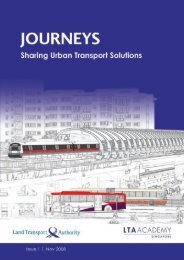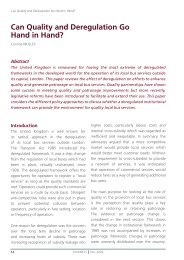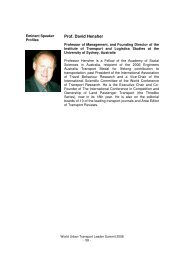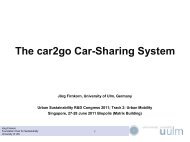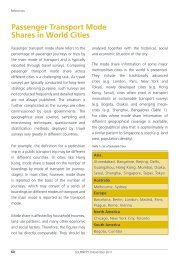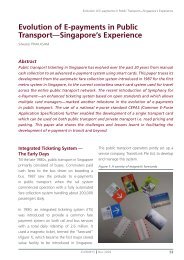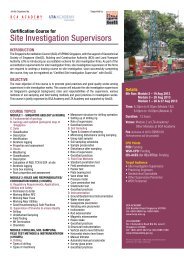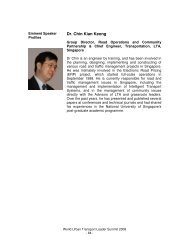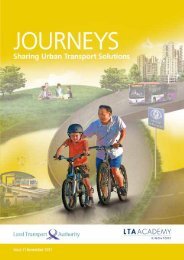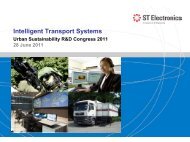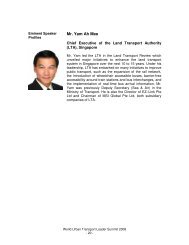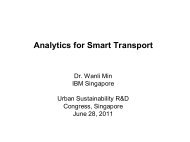Issue 4 May 2010 - LTA Academy
Issue 4 May 2010 - LTA Academy
Issue 4 May 2010 - LTA Academy
You also want an ePaper? Increase the reach of your titles
YUMPU automatically turns print PDFs into web optimized ePapers that Google loves.
Household Interview Surveys from 1997 to 2008 – A Decade of Changing Travel Behaviours<br />
Table 1: Singapore Population, GDP per Capita, Economic Activities and Daily Trips Made<br />
grew by 33 percent between 1997 and 2008,<br />
matching the growth rates in trips, suggesting<br />
that there is a close relationship between<br />
economic development and travel demand.<br />
However, the increase in trips generated<br />
cannot be attributed to economic activities<br />
alone. It is found that in 2008, each person<br />
made an average of 2.18 trips on a typical<br />
day (Table 1), an increase from previous<br />
survey years when the trip rates were 1.98<br />
and 1.97 trips per person in 1997 and 2004,<br />
respectively. Taking into account Singapore’s<br />
unemployment rates during the survey years,<br />
trip rates below 2.0 are to be expected. This<br />
explains why the trip rate dropped slightly in<br />
2004 as unemployment rose. However, as<br />
the employment situation improved in 2008,<br />
54<br />
Year Population<br />
(mil)<br />
GDP per Capita<br />
($’000 at 2000 prices)^<br />
Resident<br />
Unemployment Rate*<br />
JOURNEYS <strong>May</strong> <strong>2010</strong><br />
Daily Trips<br />
(mil)<br />
Daily Trips<br />
Per Capita<br />
1997 3.8 36.2 3.5% + 7.5 1.98<br />
2004 4.2 (11%) 44.2 (22%) 4.4% 8.2 1.97<br />
2008 4.8 (14%) 48.3 (9%) 3.2% 9.9 2.18<br />
(Note: Numbers are rounded off; figures in brackets refer to the change from the previous period.)<br />
^ From Singapore Department of Statistics’ website (http://www.singstat.gov.sg/)<br />
* From Ministry of Manpower’s website (www.mom.gov.sg)<br />
+ This is 1998’s unemployment rate as the 1997 figure is not available.<br />
Table 2: Purpose for Travelling (Forward Trips Only)<br />
the trip rate overshot the 2.0 benchmark,<br />
suggesting that individuals were making more<br />
discretionary trips that were driven by social<br />
and leisure activities.<br />
Based on the questions on trip purpose, it is<br />
possible to better understand the reasons for<br />
travelling. As seen from Table 2, most of the<br />
journeys generated are to and from homes<br />
and workplaces and for personal business<br />
and educational purposes – together they<br />
accounted for close to 80 percent of all<br />
the daily trips. This result had not changed<br />
drastically for the decade. However, a trend<br />
observed is that more private vehicle trips<br />
were made in servicing passengers3 (pick up<br />
or drop off) as the proportion of such trips had<br />
increased from 6 – 7 percent (about 500,000<br />
Purpose HITS 1997 HITS 2004 HITS 2008<br />
Go home 43% 45% 45%<br />
Go to workplace 25% 23% 21%<br />
Part of work (Travelling on business) 4% 3% 2%<br />
Go to school 8% 8% 10%<br />
Home/Work/School Sub Total 79% 79% 78%<br />
Personal business 4% 5% 3%<br />
Recreation/Social, Shopping and Eating 10% 10% 10%<br />
Other Reasons Sub Total 14% 15% 14%<br />
Serve Passenger (eg: pick up/drop off) 7% 6% 8%<br />
(Note: Numbers are rounded off.)<br />
The proportion of work/education related trips remained stable while there is a growing trend of more trips servicing passengers



